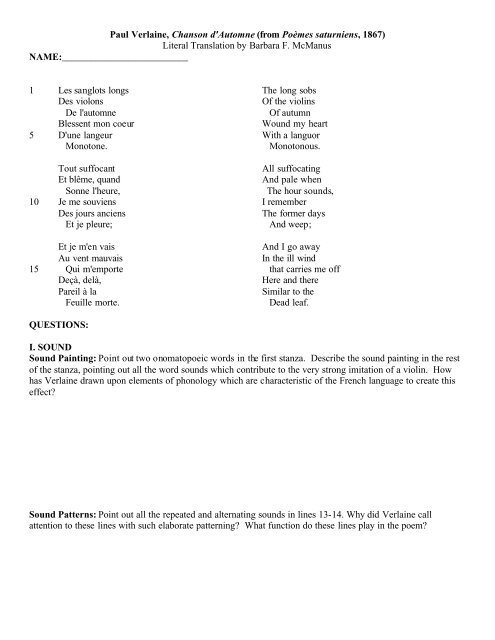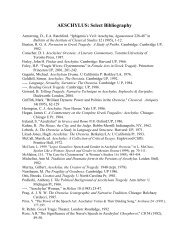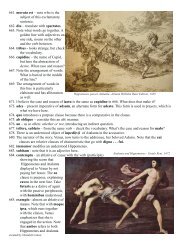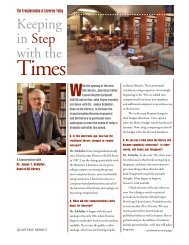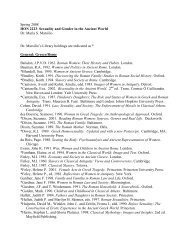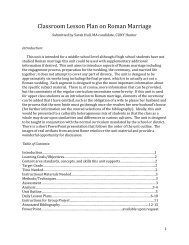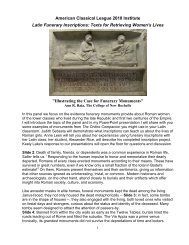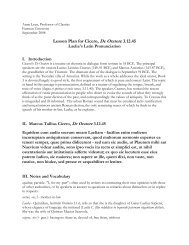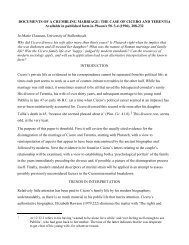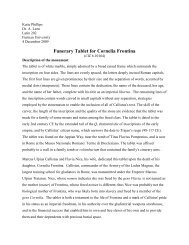Paul Verlaine, Chanson d'Automne (from Poèmes saturniens, 1867 ...
Paul Verlaine, Chanson d'Automne (from Poèmes saturniens, 1867 ...
Paul Verlaine, Chanson d'Automne (from Poèmes saturniens, 1867 ...
You also want an ePaper? Increase the reach of your titles
YUMPU automatically turns print PDFs into web optimized ePapers that Google loves.
<strong>Paul</strong> <strong>Verlaine</strong>, <strong>Chanson</strong> <strong>d'Automne</strong> (<strong>from</strong> Poèmes <strong>saturniens</strong>, <strong>1867</strong>)<br />
Literal Translation by Barbara F. McManus<br />
NAME:__________________________<br />
1 Les sanglots longs<br />
Des violons<br />
De l'automne<br />
Blessent mon coeur<br />
5 D'une langeur<br />
Monotone.<br />
Tout suffocant<br />
Et blême, quand<br />
Sonne l'heure,<br />
10 Je me souviens<br />
Des jours anciens<br />
Et je pleure;<br />
Et je m'en vais<br />
Au vent mauvais<br />
15 Qui m'emporte<br />
Deçà, delà,<br />
Pareil à la<br />
Feuille morte.<br />
The long sobs<br />
Of the violins<br />
Of autumn<br />
Wound my heart<br />
With a languor<br />
Monotonous.<br />
All suffocating<br />
And pale when<br />
The hour sounds,<br />
I remember<br />
The former days<br />
And weep;<br />
And I go away<br />
In the ill wind<br />
that carries me off<br />
Here and there<br />
Similar to the<br />
Dead leaf.<br />
QUESTIONS:<br />
I. SOUND<br />
Sound Painting: Point out two onomatopoeic words in the first stanza. Describe the sound painting in the rest<br />
of the stanza, pointing out all the word sounds which contribute to the very strong imitation of a violin. How<br />
has <strong>Verlaine</strong> drawn upon elements of phonology which are characteristic of the French language to create this<br />
effect?<br />
Sound Patterns: Point out all the repeated and alternating sounds in lines 13-14. Why did <strong>Verlaine</strong> call<br />
attention to these lines with such elaborate patterning? What function do these lines play in the poem?
Rhyme: Identify all the rhyming words in the poem according to part of speech (e.g., noun, adjective, adverb,<br />
etc.). Are the rhymes full or partial? Give an example of rhyming words that are the same parts of speech and<br />
ones that are different. What type is used more often in this poem, and how does that enhance the meaning of<br />
the poem?<br />
II. METER (Practice reading the poem aloud to bring out the sounds, rhythm, and meter. Since this is such a<br />
short poem, each of the French students should read it aloud.)<br />
Describe the meter of this poem. Break lines 1-6 into syllables, counting the number of syllables in each line<br />
and marking the rhyme scheme with letters of the alphabet, indicating which of the rhymes are masculine or<br />
feminine. Does this rhyme scheme persist throughout the poem?<br />
III. DICTION AND SYNTAX<br />
Collocation: In what collocation (context) might you expect to see the words blessent, coeur, langeur,<br />
suffocant, blême, mauvais, and morte appear together? What does this suggest about the theme of the poem?
Connotation: What is the connotation of the adjective monotone (l. 6), and how does this connotation work<br />
with the noun langeur (l. 5)? What is the connotation of the adjective anciens (l. 11) and what effect does this<br />
have on the poem?<br />
There are only 9 nouns in the poem, and only three of these refer to concrete objects (coeur, violons, feuille);<br />
these three all belong to the figurative dimension of the poem. What effect does this lack of concreteness and<br />
specificity have on the poem?<br />
IV. IMAGERY AND FIGURATION<br />
Imagery: As already noted, sound imagery dominates in this poem. Can you find any visual imagery at all?<br />
What effect does this lack of concrete imagery have on the poem?
Metaphor: Find two metaphors in lines 1-4 and explain the vehicle, tenor, and connection of each (note that the<br />
first also includes a faint personification, and second includes metonymy). How do these metaphors set the tone<br />
for the rest of the poem?<br />
Metonymy: Find an example of metonymy in line 9. What does this contribute to the poem?<br />
Simile: Find a simile in lines 17-18 and explain the vehicle, tenor, and connection. Why do you think that this<br />
simile closes the poem?
V. VIRTUAL WORLD<br />
Genre: Does this poem belong to any established genre? If not, why do you think <strong>Verlaine</strong> chose not to use an<br />
established poetic genre? (Note what was happening on the artistic scene at the time this poem was written and<br />
the fact that this poem was included in a section entitled Paysages tristes (“sad or melancholy landscapes”).<br />
VI. TONE<br />
Speaker: Is the narrative first- or third-person? Is the narrator a participant or an observer? gendered or<br />
ungendered? omniscient or limited? intrusive or objective? Point to elements in the poem which explain your<br />
answers to these questions.<br />
Addressee: Is the poem addressed to a specific person or a generalized audience?
Subject: What is this poem about, and how is this subject matter connected to the speaker? What are the<br />
dominant emotions, and are we ever told the reasons for these emotions?<br />
Form: What is the relationship between the emotions expressed and the form of their expression (does the form<br />
mimic, contradict, or stand in tension with the emotion)?


